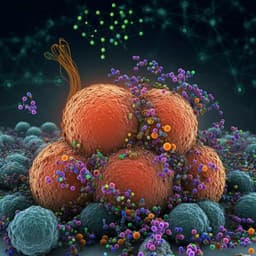Introduction
In vivo monitoring of polymers is essential for advancing drug delivery systems and tissue regeneration techniques. Magnetic Resonance Imaging (MRI) offers a powerful, non-invasive whole-body imaging method. Heteronuclear MRI, focusing on nuclei besides ¹H, expands the capabilities of MRI by providing quantitative information and unique “hot spot” visualization. However, existing heteronuclear MRI agents, often based on perfluoroalkyl substances (PFAS), present significant drawbacks: they are persistent environmental pollutants, accumulate in organs, and pose challenges in terms of stability and functionalization. This research proposes a sustainable alternative using biocompatible and biodegradable polyphosphoesters (PPEs). PPEs offer advantages due to their diverse chemistry and potential for stealth coatings. The use of ³¹P nuclei within the polymer backbone for imaging offers a unique advantage, leveraging the inherent biocompatibility of PPEs and avoiding the use of PFAS. However, utilizing ³¹P for MRI is challenging due to low sensitivity, background signals from natural phosphates, and unfavorable relaxation times. This study aims to overcome these challenges by strategically modifying the molecular environment of ³¹P, creating colloidal nanostructures to enhance signal strength, and adjusting polymer microstructure to optimize relaxation times, thereby establishing PPEs as a viable and sustainable alternative for MRI-traceable biomedical polymers.
Literature Review
Current methods for imaging polymeric materials in vivo often rely on labeling techniques, for instance, by encapsulating PFAS within nanocarriers or hydrogels for heteronuclear MRI. While effective in some applications, PFAS present environmental concerns due to their persistence. Research focuses on improving PFAS properties or exploring alternative materials for 19F MRI. 19F MRI has shown promise in various biomedical applications such as cardiovascular disease imaging, cancer detection, and monitoring cell therapies and biomaterials. However, the use of PFAS is increasingly questioned due to their environmental impact and potential for organ accumulation. ³¹P NMR spectroscopy has been used for pH sensing and detecting metabolites, but its application to MRI-traceable materials has been limited by low sensitivity and background interference from natural phosphates. While some studies have explored phosphorus-containing polymers for 31P MRI, they often lack biodegradability or background-free capabilities. This study uniquely utilizes the inherent properties of polyphosphoesters, aiming for a sustainable, background-free, biodegradable, and drug-delivering theranostic agent.
Methodology
To address the challenges of ³¹P MRI, the researchers employed a three-pronged approach:
1. **Background-free imaging**: Polyphosphonates (PPn) were used due to their unique P-C bond, shifting their chemical resonance frequency away from that of endogenous phosphates, allowing for selective detection. Side-chain modification further tuned the chemical shift, creating multiple MRI “colors”.
2. **Signal enhancement**: Amphiphilic block copolymers self-assembled into colloidal nanostructures (micelles), concentrating ³¹P and increasing the signal intensity. Two types of micelles were initially prepared: PPnCORE with a ³¹P-containing hydrophobic core and a hydrophilic shell and PPnSHELL with a ³¹P-containing hydrophilic shell and hydrophobic core.
3. **Relaxation time optimization**: Polymers with low glass transition temperatures (Tg) were designed to improve relaxation times (T1 and T2) resulting in higher signal-to-noise ratios (SNR). Initial attempts with hydrophobic polyphosphonates yielded too short a T2, prompting the use of amphiphilic block copolymers and subsequently gradient copolymers to improve T2 relaxation times.
Gradient copolymers were synthesized using a single-step anionic ring-opening copolymerization of phenyl- and ethyl-functional monomers, creating a gradient microstructure confirmed by kinetic measurements and Monte Carlo simulations. These gradient copolymers (PPnGRAD) self-assembled into micelles with a narrow size distribution and low critical micelle concentration. The gradient microstructure further enhanced mobility and increased T2, boosting SNR. Multi-chemical selective imaging (mCSSI) was used to improve SNR in samples containing multiple NMR signals by summing the individual images, significantly improving the detectability of the micelles.
In vivo studies utilized Manduca sexta caterpillars, chosen for their hemolymph volume comparable to mouse blood, aligning with the 3R principles of animal welfare. Micelles were injected into the caterpillars, with both ¹H and ³¹P MRI employed for imaging. Biodegradation was assessed by analyzing the feces for ³¹P NMR signals indicating the presence of low-molecular-weight degradation products.
Drug delivery potential was evaluated by encapsulating the hydrophobic drug PROTAC (ARV-825) within the PPnGRAD micelles via nanoprecipitation. The resulting micelles maintained stability and showed comparable cytotoxicity and apoptosis induction in HeLa cells as free PROTAC, demonstrating potential for theranostic applications. Various characterization techniques like size exclusion chromatography (SEC), NMR spectroscopy, dynamic light scattering (DLS), fluorescence spectroscopy, atomic force microscopy (AFM), and differential scanning calorimetry (DSC) were used to comprehensively characterize the polymers and micelles.
Key Findings
The study successfully demonstrated that biodegradable polyphosphoester micelles can serve as effective background-free ³¹P MRI agents and drug nanocarriers. Specifically:
* **Background-free ³¹P MRI**: The use of polyphosphonates (PPn) and careful tuning of their chemical environment resulted in the separation of the micelles' ³¹P signal from natural phosphate backgrounds, enabling selective imaging.
* **Enhanced MRI characteristics**: The self-assembly of amphiphilic gradient copolymers into micelles significantly improved the T2 relaxation times, leading to a three-fold increase in SNR compared to block copolymers. The gradient structure, confirmed by both kinetic analysis and Monte Carlo simulations, significantly impacted the mobility of the polymer chains. Multi-chemical selective imaging (mCSSI) was used for optimal detection.
* **In vivo imaging and biodegradation**: Successful in vivo ³¹P MRI was achieved in Manduca sexta caterpillars, demonstrating the circulation and distribution of PPnGRAD micelles. Biodegradation was confirmed by detecting characteristic degradation products in the caterpillar's feces via ³¹P NMR spectroscopy.
* **Drug delivery capabilities**: The micelles effectively encapsulated the hydrophobic drug PROTAC (ARV-825), maintaining stability and demonstrating similar cytotoxic effects on HeLa cells compared to free PROTAC, highlighting the micelles' potential for theranostic applications. The loading of PROTAC into PPnGRAD micelles prevented precipitation of this poorly water-soluble drug, unlike formulations of PROTAC alone.
Discussion
The results address the research question by demonstrating that biocompatible and biodegradable polyphosphoester micelles can effectively function as both background-free ³¹P MRI contrast agents and drug delivery vehicles. The successful in vivo imaging and biodegradation in Manduca sexta caterpillars validate the suitability of these micelles for biomedical applications. The improved SNR achieved with the gradient copolymer micelles compared to block copolymer micelles highlights the importance of microstructure design in optimizing MRI characteristics. The demonstration of drug encapsulation and delivery expands the potential of this platform toward theranostics, combining diagnosis and therapy. This approach offers a significant advantage over traditional PFAS-based contrast agents by providing a biodegradable and environmentally friendly alternative, reducing the risk of organ accumulation and environmental pollution. Future studies could investigate various animal models to evaluate biodistribution and pharmacokinetics, explore different therapeutic payloads, and assess long-term effects in vivo.
Conclusion
This study successfully developed a novel platform using biocompatible and biodegradable polyphosphoester micelles for background-free ³¹P MRI and drug delivery. The optimized gradient copolymer microstructure resulted in enhanced MRI characteristics and efficient drug encapsulation. In vivo studies validated the imaging capabilities and biodegradability of the micelles. The demonstration of effective drug delivery using PROTAC showcases its potential for theranostic applications. Future work should explore applications in diverse animal models, evaluate the long-term effects of these micelles, and assess their efficacy in different disease models.
Limitations
The in vivo studies were conducted in Manduca sexta caterpillars, which may not fully recapitulate the complexities of mammalian physiology. The biodistribution of the micelles in mammals should be studied for complete evaluation. The study focused on a single drug, PROTAC, so further research is needed to evaluate the versatility of this platform for delivering a broader range of therapeutic molecules. Long-term studies are needed to comprehensively investigate potential toxicity profiles of the PPE micelles. Furthermore, a more detailed comparison with established 19F MRI agents in similar in vivo settings would further strengthen the findings.
Related Publications
Explore these studies to deepen your understanding of the subject.







